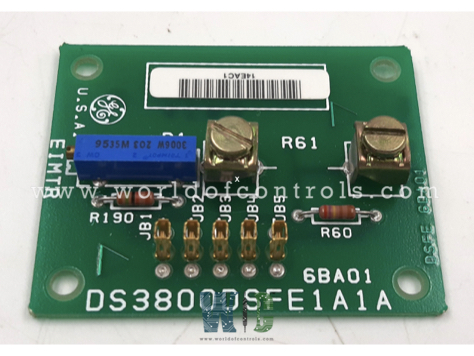
World Of Controls understands the criticality of your requirement and works towards reducing the lead time as much as possible.
DS3800DSFE1A1A - Synchronized Field Daughter Card is available in stock which ships the same day.
DS3800DSFE1A1A - Synchronized Field Daughter Card comes in UNUSED as well as REBUILT condition.
To avail our best deals for DS3800DSFE1A1A - Synchronized Field Daughter Card, contact us and we will get back to you within 24 hours.
SPECIFICATIONS:
Part Number: DS3800DSFE1A1A
Manufacturer: General Electric
Series: Mark IV
Product Type: Synchronized Field Daughter Card
Input Voltage Range: 24V DC
Field Voltage Range: Up to 500V DC
Max Output Channels: 6-12 outputs
Communication Protocols: Modbus, Profibus, Ethernet, RS-485
Power Supply: 110-240 V AC / 24 V DC
Weight: 1.5 - 3.0 kg
Operating Temperature: -20°C to +70°C
Size: 8.25 cm high x 4.18 cm
Mounting Type: DIN rail
Repair: 3-7 Day
Availability: In Stock
Weight: 2 lbs
Country of Origin: United States
FUNCTIONAL DESCRIPTION:
DS3800DSFE1A1A is a Synchronized Field Daughter Card manufactured and designed by General Electric as part of the Mark IV Series used in GE Speedtronic Gas Turbine Control Systems. The Synchronized Field Daughter Card is an advanced auxiliary module used to manage and synchronize generator field excitation parameters in turbine control systems. Its primary role is to ensure precise alignment between the generator's field voltage and current with the commands from the turbine's primary control system. This synchronization is crucial for maintaining stable and efficient generator performance, especially under dynamic operating conditions or during transitions such as startup and load changes. The card is typically designed to interface seamlessly with the existing system, expanding its functionality and improving control precision.
FUNCTIONS OF THYRISTOR FAN OUTBOARD :
WOC has the largest stock of OEM replacement parts for GE Speedtronic Control Systems. We can also repair your faulty boards and supply unused and rebuilt boards backed up with a warranty. Our team of experts is available round the clock to support your OEM needs. Our team of experts at WOC is happy to assist you with any of your automation requirements. For pricing and availability on parts and repairs, kindly contact our team by phone or email.
What is the purpose of the Synchronized Field Daughter Card?
The Synchronized Field Daughter Card is designed to manage and synchronize the excitation parameters of a generator’s field. It ensures that the field voltage and current align with system and grid requirements, optimizing generator performance and stability during dynamic operations.
How does the card achieve synchronization?
The card uses advanced algorithms to monitor the generator’s field excitation parameters. It adjusts the field voltage and current dynamically, ensuring precise alignment with the grid’s frequency and phase. This synchronization prevents issues like power imbalances and supports stable generator operations.
What communication protocols are supported?
The card supports widely used industrial protocols, including Modbus, Profibus, Ethernet, and RS-485. These enable seamless integration with SCADA systems and turbine control units, facilitating real-time monitoring, data exchange, and centralized control.